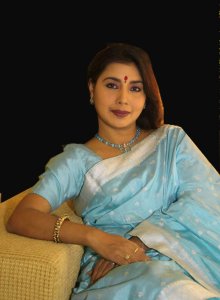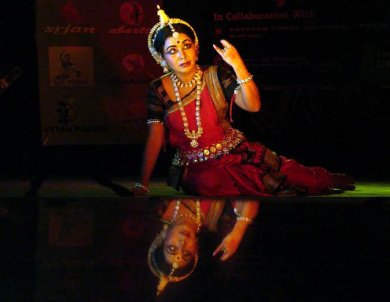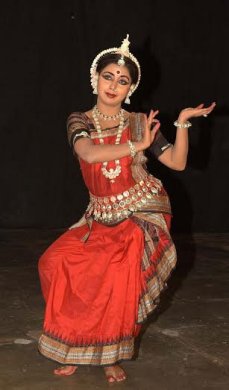
|
 |

|
 |
Aruna Mohanty: The thinking dancer - Sutapa Patnaik e-mail: sutapapatnaik@gmail.com July 6, 2014  Odissi dancer-choreographer-guru Aruna Mohanty is known globally for her innovative productions that harmoniously blend indigenous explorations with contemporary cultural sensibilities. While 15 out of her 59 compositions are based on the 12th century saint poet Jayadeva's Geeta Govinda, she has also explored with equal ease unusual themes like the Odisha super cyclone, Krishna for the contemporary world, apart from some modern Odia poetry. Her latest venture is based on German Nobel laureate Hermann Hesse's Siddhartha. Her research on representation of the male dancer in classical sculpture and evolution of Odissi in the post-Independence era are widely appreciated. Here are some excerpts from an interview conducted at her Bhubaneswar home recently dealing with her thoughts on the art of choreography. Are you aware that you are widely recognized as a thinking dancer? It is nice to know that people consider me to be a thinking dancer. But I don't think I am God's Sunday creation. Everyone learns by observing people and from the environment one is in. I am very fortunate that in my journey of dance, which began in the 1960s, I met people who were very generous. My parents, my gurus and well-wishers have all helped me see the road ahead of me. Like a child, I continue to learn from authority figures, peers and people I'm surrounded with. I'm always hungry to know more and to appreciate people for their good work. This helps me to learn a few things which I try and incorporate into my work. I haven't stopped learning because I think I have so much more to learn, and I'm doing so little. In that, I'm like a student; and I do think. But then, every dancer does. The sad part is, very few dancers communicate their ideas through their work, while most refrain from expressing in action what they think because either they are too happy following a set of guidelines to project their art, or they believe people will not understand their viewpoint and hence withhold their creative potency. You feel that most dancers are hesitant to experiment with new choreographic patterns for the fear of negative response? Yes, absolutely! See, too much of standardization in any process is the result of excessive mechanization which has very little scope in a free-thinking, free-flowing, continuity-based art form like dance. Here, one has to have the freedom and space for expression. Although many dancers have a strong desire to bring into their art a conscious innovation, only a few engage meaningfully in the activity. This is mostly because dancers are aware that by presenting to the audience new compositions which do not adhere to familiar standards of choreographing and/or evaluating a dance item, they would invariably invite criticism. So, they resort to the more convenient path of tracing the outlines of celebrated gurus' choreographic masterpieces. What some dancers don't realize is that an exaggerated sense of fear of non-approval or rejection may impede their creative growth. It has happened to so many people. If they expect people to appreciate their work, they should be prepared to accept criticism, too. It is high time talented dancers made good use of their creative forces and conveyed their own interpretation of concepts through their work, without being too conscious of public opinion.  Is there is a lurking fear in some segments of the dance fraternity that too much innovation may result in uncontrollable advancements in some directions and perceptions, which would eventually render the traditional framework blurred and ambiguous? Most dancers are aware that the framework of tradition is broadly defined and everything boils down to how aesthetically a piece is choreographed. If I speak specifically about Odissi, the grammar is so vast that it offers ample scope to include new dimensions and interpretations, while keeping its classical uniqueness intact. So, there is little reason for dancers to limit their creative dimensions. A dancer is a student first. A rational student understands the foundation of the classical art form, its boundaries in terms of geography and history of the region to which the art form belongs, the lifestyle of the people and their value system, the language spoken, the norms , the music, and finally the grammar and nuances of the dance. Only then is the understanding of that particular dance form complete. Sonal Mansingh, Madhavi Mudgal, Sharmila Biswas, to name a few, are all known as intellectual dancers. The reason is, even as non-Odias, they know about Odisha and its culture much more than many Odias do. They have been to different regions of Odisha and studied deeply the smallest of mannerisms, including how the women of the region tie the saree, how they do their hair, how they walk up to the pond/river to collect water, or what sarcastic comments they make and when, so on and so forth. All this is so important. I admire Sharmila Biswas for her body of work. I find her choreography mind blowing! I often tell her, "Sharmila, I would like to open your mind and see how you think." I think highly of Madhavi-ji and Sonal-ji. They are outstanding. I often wonder how they think. As a choreographer, what do you think are the main challenges of blending the modern sensibilities with the traditional elements of dance? 'Tradition' and 'modern' are relative terms. The definition of each term is vast and varied. What is modern today will be tradition tomorrow. What ultimately matters is how aesthetically one displays the art in the present time on the basis of knowledge from the past. Therefore, the real challenge for a choreographer is to have a basic sense of auchitya or appropriateness in the deliberation and execution of a concept. This reminds me of an occasion when I asked Guru Kelucharan Mohapatra, "How do you say so convincingly that Radha would act this way or react that way?" He answered disarmingly, "Haven't I observed my mother, my aunts and my sisters when they went to the river to collect water, or how they participated in the village gossip about clandestine love affairs?" The life he had seen - his contemporary experience - was reproduced by him in his compositions. Today, if I don't take elements from my contemporary experience and use them in my dance to create something new, then I'm surely doing a great disservice to my art by failing to connect the past with the present. In my recent production Ki Naada Re, I wanted Odia, Sanskrit and Hindi excerpts from literature for the characters of Yashoda, Radha and Meera respectively, to give it a distinctive flavor. I insisted on taking the traditional poems for the characters but used the scriptwriter's words for the narration. This is my idea of blending the modern with the traditional in the script. The process of evolution involves linking the past with the present and carrying to the future a refined sense of art and aesthetics. I believe it is the collective responsibility of all dancers to pass on the creative baton to the next generation. If they shirk the responsibility of providing to the next generation a gradual transition in dance by responding to new ideas, it will be the end of the road. We would then be left with a dead tradition, not a living one.  How do you identify the uniqueness of a concept for a new creation? When we take some clay and try to give it a shape, we are not sure what the final product is going to be. In the process of developing a shape, the creator continuously experiments with ideas. The outcome may not be good enough to be appreciated. But this should not prevent one from extending the artistic dimensions. Similar is the case while choosing a concept. In Ki Naada Re, the theme revolves around three women in Krishna's life - Yashoda, Radha and Meera. To me, all three of them are equally powerful. When I look at the three women, I see one thing in common among them - their love for Krishna - which comes through Naada. Then, we also deal with how they are different from each other. Each of them feels differently for Krishna: One sees Him as her son, the other sees Him as her beloved, and the third sees Him as her God. Hence, each one uniquely expresses her love for Krishna. A few years ago, I used well-known Odia litterateur Mayadhar Mansingh's modern poem in dance. Although I received some good reviews for the composition, I remember the initial reaction of the seniors was unfavorable. I accepted their not-so-charitable remarks out of respect for them, while not completely agreeing with their perception of my work. Currently, I'm working on Hermann Hesse's Siddhartha. What, according to you, are the necessary elements for choreographing a dance item? I'll speak for myself. While composing a piece, I don't think of the audience first. For me, the choice of theme is paramount. It has to excite me. After etching out the characters of the concept, comes the role of the scriptwriter whose work is to seamlessly connect them all. I visualize the entire piece. When a dance is presented, it is the choreographer's responsibility to ensure that the audience gets to see dancers in beautiful costumes on an aesthetically designed stage with proper lighting, and the best music wafting across with perfect sound balance controls in place. So, I sit with the scriptwriter, the music director, the light designer, the sound engineer and the costume designer - sometimes separately, and at other times, with some or all of them together - for discussing my requirements for my production in their respective departments. In the course of discussions, we disagree on many points. We go back and forth many times over and a lot of churning takes place before we reach a desired conclusion. I'm very happy when my music director, light designer, the scriptwriter or costume designer don't agree with me. That makes me think a little more. However, disagreement of any kind doesn't mean there is a conflict. We respect each other a lot. I work equally hard on the script, song, instrument, rhythm, steps, movements, hand gestures, facial expressions, positioning of the body, entrance and exit. Everything has to be perfect to create the right impact. When that impact is created, the audience transcends to a higher consciousness. That is when the audience becomes part of the production. As long as that is accomplished, I'm happy with what I'm doing. Contact Aruna Mohanty: aruna.odissi@gmail.com A former student of Odissi dance from Odisha, Hyderabad-based Sutapa Patnaik quit her career as editor for some Indian and American publications to focus fully on writing on Odissi. She has undertaken intensive research and documentation on Guru Pankaj Charan Das, the guru of gurus in Odissi dance. She has also been the Associate Editor of Odissi Annual, the year book on Odissi. Post your comments Unless you wish to remain anonymous, please provide your name and email id when you use the Anonymous profile in the blog to post a comment. All appropriate comments posted with name & email id in the blog will also be featured in the site. |